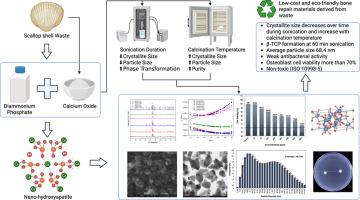Synergistic effects of sonication duration and calcination temperature on the structural, physicochemical and bioactivity of biogenic nano-hydroxyapatite from scallop shells for bone repair applications
IF 4.7
3区 材料科学
Q2 MATERIALS SCIENCE, MULTIDISCIPLINARY
引用次数: 0
Abstract
This study explores the synergistic effects of sonication duration and calcination temperature on the synthesis of biogenic nano-hydroxyapatite from scallop shell waste for bone repair applications. The synthesis involved wet ball milling and sonochemical treatment at 30 and 60 min of sonication, followed by calcination at 900 °C, 1000 °C, and 1100 °C. Increasing the calcination temperature led to larger crystallite size due to the effect of coalescence phenomenon and greater unit-cell volume. A sonication duration of 60 min promoted the formation of β-tricalcium phosphate (β-TCP). The combination of 60 min of sonication and calcination at 900 °C produced hydroxyapatite with the smallest crystallite size with hexagonal structure, lowest unit-cell volume, and an average particle size of 68.4 nm. Cytotoxicity tests confirmed the material's biocompatibility, with osteoblast (MC3T3-E1) cell viability exceeding 70 %. Antibacterial tests revealed weak inhibition against Escherichia coli and Staphylococcus aureus, suggesting potential for further enhancement. Overall, scallop shell waste provides a sustainable, low-cost source for producing bioactive nano-hydroxyapatite, supporting the eco-friendly development of bone regeneration materials. Future work should optimize antibacterial performance and assess in vivo efficacy.

超声时间和煅烧温度对扇贝纳米羟基磷灰石的结构、物理化学和生物活性的协同作用
本研究探讨了超声时间和煅烧温度对扇贝废物合成生物源纳米羟基磷灰石的协同作用。合成过程包括在30和60分钟的超声下进行湿球磨和声化学处理,然后在900°C, 1000°C和1100°C下进行煅烧。随着煅烧温度的升高,由于聚结现象的影响,晶粒尺寸增大,晶胞体积增大。60 min的超声时间促进了β-磷酸三钙(β-TCP)的形成。超声60 min, 900℃煅烧制得的羟基磷灰石晶体尺寸最小,具有六方结构,单位细胞体积最小,平均粒径为68.4 nm。细胞毒性试验证实了材料的生物相容性,成骨细胞(MC3T3-E1)细胞存活率超过70%。抗菌试验显示对大肠杆菌和金黄色葡萄球菌的抑制作用较弱,提示进一步增强的潜力。总的来说,扇贝壳废料为生产具有生物活性的纳米羟基磷灰石提供了可持续、低成本的来源,支持了骨再生材料的环保发展。未来的工作应优化抗菌性能和评估体内疗效。
本文章由计算机程序翻译,如有差异,请以英文原文为准。
求助全文
约1分钟内获得全文
求助全文
来源期刊

Materials Chemistry and Physics
工程技术-材料科学:综合
CiteScore
8.70
自引率
4.30%
发文量
1515
审稿时长
69 days
期刊介绍:
Materials Chemistry and Physics is devoted to short communications, full-length research papers and feature articles on interrelationships among structure, properties, processing and performance of materials. The Editors welcome manuscripts on thin films, surface and interface science, materials degradation and reliability, metallurgy, semiconductors and optoelectronic materials, fine ceramics, magnetics, superconductors, specialty polymers, nano-materials and composite materials.
 求助内容:
求助内容: 应助结果提醒方式:
应助结果提醒方式:


